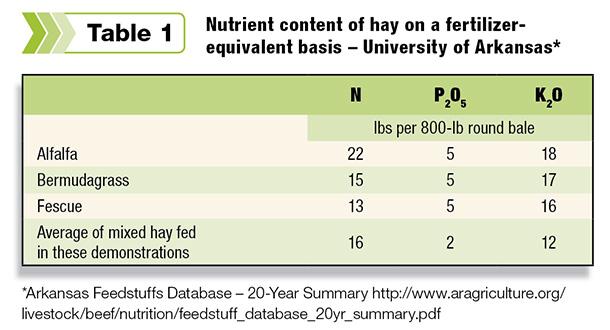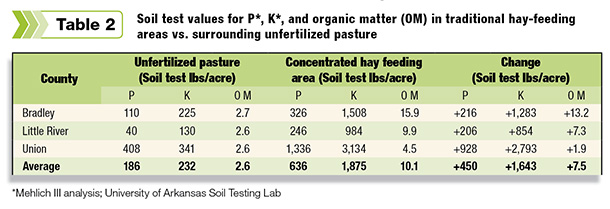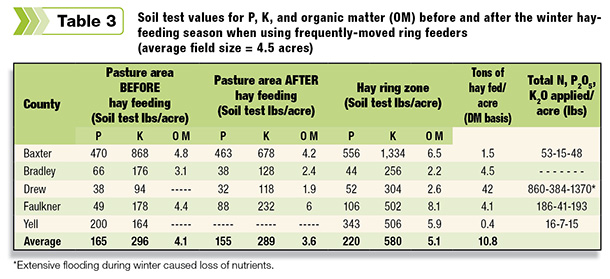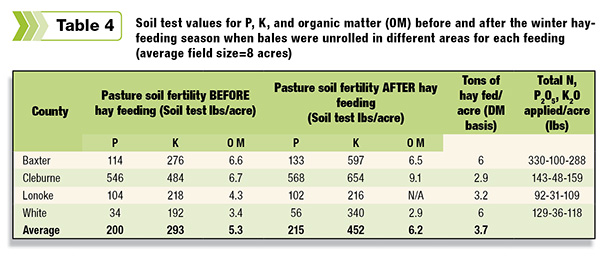Often producers feed hay in the same areas year after year simply for convenience or because other fields become wet during the winter. The main value of hay is for feeding livestock, but it also has value as a fertilizer amendment.

Each bale of hay contains substantial amounts of fertilizer nutrients that can enrich feeding areas. On average, a typical 4-by-5 round bale has a fertility value approaching that of 100 pounds of 17-17-17 fertilizer (Table 1).
Cattle do not improve soil fertility through grazing or consuming hay, but they can help recycle nutrients from forage and feed.
As livestock consume the hay, most of the phosphorus and potassium pass through the animal in manure and urine and become recycled in the soil. Nutrients in wasted, uneaten hay also become recycled over time.
Many farmers have understood this for years and routinely feed hay in areas with poor fertility to “build up the ground.”
Ironically, little work has been done to document the value of hay as a fertilizer source for building soil fertility.
Research protocol
In Arkansas, we conducted on-farm demonstrations through a project funded by the Arkansas Grazing Lands Coalition to measure the impact of hay feeding on soil fertility.
The basic approach was to soil test designated hay-feeding areas before and after the hay-feeding season. The hay-feeding season across different farms generally lasted from November through March.
The herd size among farms ranged from 30 to 90 cows. Hay fed on most farms included mixed grasses such as bermudagrass, bahiagrass, dallisgrass and annual ryegrass.
Hay was tested for nutrient content (Table 1) and the amount of hay fed was recorded. Demonstrations were divided into three groups: traditional hay-feeding area versus unfertilized pasture, hay feeding in ring feeders moved within the feeding area, and hay feeding by unrolling bales across the feeding area.
Farm sizes, herd numbers and length of feeding season varied across farms, but similar protocols for feeding and soil sampling were followed for each demonstration group.
Traditional hay-feeding area versus unfertilized pasture
Producers that feed hay in the same location every year are missing the fertility value hay has to offer. Soil tests from traditional concentrated hay-feeding areas (typically less than 1 acre in size) showed substantially higher fertility than surrounding unfertilized pastures (Table 2).
On average, soil test P and K were 450 and 1,643 pounds per acre higher in the hay-feeding area. Organic matter averaged 7.5 percent higher as well.
Weed problems were common in concentrated hay-feeding areas because trampling during winter destroyed areas of grass sod around feeders. Moving hay-feeding areas each year or even during the winter season can spread the nutrients and can help promote forage growth in other areas.
Hay feeding in ring feeders moved within the feeding area
In demonstrations with hay-ring feeding, the average size of the designated feeding area was 4.5 acres. Soil samples were taken over the entire area before and after the feeding period.
In addition, samples were taken in the immediate areas where hay-ring feeders were placed. Efforts were made to move the ring feeders for each hay feeding.
Average fertility increases were not as evident after one winter’s hay feeding for whole-field soil samples (Table 3).
In some cases, soil test levels appeared slightly lower after feeding. This result may be due to variability associated with soil sampling, incomplete coverage of the feeding area with hay and incomplete nutrient cycling of hay waste and manure.
However, fertility increases were evident in the areas immediately surrounding the ring feeders where trampling increased soil incorporation of waste hay and manure.
This suggests that to optimize distribution of nutrients in hay, ring feeders should be moved frequently.
Hay feeding by unrolling bales across the feeding area
In demonstrations where hay bales were unrolled, the average size of the designated feeding area was 8 acres. Soil samples were taken over the entire area before and after the feeding period.
Bales were unrolled in a different location for each hay feeding. Fertility increases over the entire field were more consistent after one winter’s hay feeding than for the ring-feeding sites (Table 4).
Unrolling hay likely covered more area and spread nutrients more evenly across the field than with ring feeders.
Application of specific rates of fertilizer nutrients from any nutrient source does not result in an equivalent pound-for-pound increase in soil test levels.
In addition, the short-term timespan of this project may have been insufficient to measure complete nutrient cycling from the hay and manure. Considerable variability was observed due to differing field and farm conditions.
However, the average results of these demonstrations suggest that hay feeding can be an effective method to improve soil fertility over time. The method of hay feeding is often a personal choice.
Other demonstrations conducted in Arkansas indicate that hay waste averaged 13 percent when using ring feeders but was almost double at 24 percent when unrolling hay (when more hay was offered than cattle could consume in a short period).
Another approach
Another approach to reducing hay waste and to evenly distribute nutrients is to “strip-feed” hay using a temporary electric fencewire.
During the severe drought of 2012, hay was very expensive and difficult to find. One producer, when feeding hay during the drought, observed how cattle would trample and lay on hay from bales he had just unrolled, causing increased waste.
This innovative producer was well-versed in the use of temporary electric fence, so he strung an electric polywire down the length of the line of unrolled hay. The cows immediately lined up on each side as if they were standing at a feed trough.
Measurements showed that even though the hay was being limit-fed, hay waste was reduced by an average of 6 percent, which resulted in an estimated savings of over $3 per bale and almost $150 per month.
He refined the technique further during winter by staging bales of hay alongside the field on the weekend and unrolling several at a time. By doing so, he could feed by simply moving the temporary electric wire to a new line of hay each day.
He started the tractor and used expensive fuel only once per week instead of every day. Cattle were allowed access to only one side of the unrolled bale.
The wire was placed just high enough to allow the cows to reach across the width of the hay line without damaging the next day’s hay. Observations indicate that nutrient distribution was very uniform, and hay waste was minimized.
Hay is an expensive part of a livestock business. To make the most of this feed source, producers should use management to harvest good-quality hay, store and feed it to reduce waste, and feed it to utilize its value as both a feed and fertilizer source. ![]()

John Jennings
Professor
Extension Forage Specialist
University of Arkansas Division of Agriculture









